The September birthstone is sapphire, revered for its deep blue hue and held significance across various cultures for centuries. This gemstone is a variety of the mineral corundum and embodies qualities such as sincerity, truth, and nobility. While the traditional image of sapphire is rich and blue, it comes in a spectrum of colors, excluding red, which is classified as ruby, another corundum.
Known for their remarkable hardness, second only to diamonds, sapphires are a popular choice for birthstone jewelry, engagement rings, and other fine jewelry. The quality of a sapphire is assessed based on its color, clarity, cut, and carat weight, with the ideal being a vibrant, medium blue. Care and maintenance of sapphire jewelry involve proper storage, regular cleaning, and avoiding harsh chemicals to maintain the stone’s luster.
The History of Sapphire
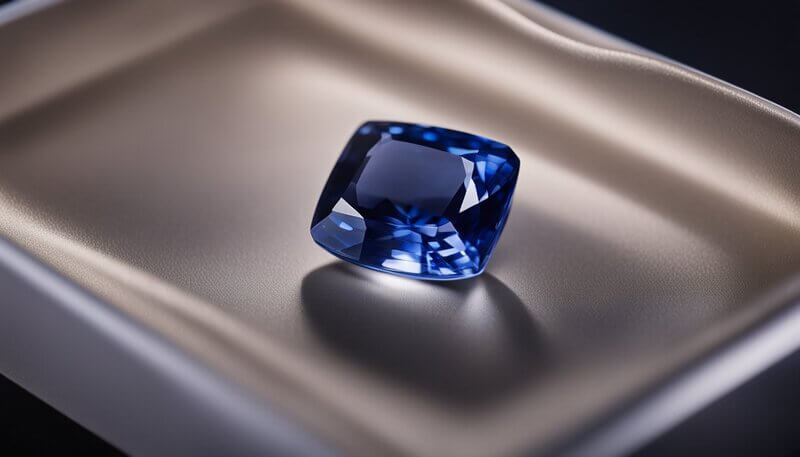
Sapphires have been cherished and valued for thousands of years. One of the earliest known references to the gem comes from Ancient Greece, where the name “sapphire” was derived from the Greek word “sapphires,” which means blue. In these ancient societies, sapphires were treasured for their beauty and belief that they offered protection and wisdom.
During the Middle Ages, sapphires were worn by royalty and as part of ecclesiastical rings. They believed the heavens mirrored the blue of the sapphires, which represented heavenly favor and provided protection from harm. The gem’s blue hue symbolized purity and was a favorite stone of kings and clergymen.
In Persian culture, sapphires were often associated with the sky. It was believed that the earth rested on a giant sapphire, and its reflection colored the sky.
| Culture | Beliefs and Uses of Sapphire |
| Ancient Greece | Protection, wisdom, divine favor |
| Middle Ages | Royalty, ecclesiastical rites, purity |
| Persians | Sky connection, earth’s foundation |
Throughout history, sapphires have been appreciated not only for their stunning beauty but also for their purported metaphysical properties. They were used as antidotes for poison, and it was said that venomous snakes would perish if placed in vessels made of sapphire. This speaks to the esteemed position sapphires have held across various cultures and periods, revered as ornaments and symbols vested with significant power and meaning.
Significance and Symbolism

The sapphire, known as the September birthstone, carries a rich tapestry of meaning and symbolism. Long valued for its deep blue hue, it encapsulates wisdom, faithfulness, and nobility. The presence of sapphire in jewelry, especially in pieces signifying commitment, indicates its association with love and devotion. Sapphires are often given to celebrate a 5th or 45th wedding anniversary, hinting at their enduring power to represent lasting relationships.
Historically, royalty has adorned sapphires, reinforcing its association with nobility. In ancient cultures, this precious gem was believed to offer protection against harm and envy. As a testament to this belief, it was worn by the clergy and the elite, linking it to truth and purity.
Sapphires are also attributed with healing properties, providing courage and strength to their wearer. It’s thought to bring about mental clarity, thus fostering inner power—a quality deeply connected to the gemstone’s symbolism. Furthermore, owning or wearing a sapphire is sometimes said to bring good fortune, an allure that continues to captivate people today.
- Wisdom: Inspires an enlightened mind and aids decision-making.
- Faithfulness: Embodies loyalty and commitment.
- Nobility: Associated with dignity and grace.
- Royalty: A historical gemstone of kings and queens.
- Protection: Thought to guard against negativity.
- Truth: Promotes honesty and clarity of thought.
- Healing: Believed to have restorative powers.
- Power and Courage: Confers strength and resilience.
- Good Fortune: Attracts prosperity and happiness.
The hardness of sapphire (second only to diamond) complements its meaning, symbolizing the gem’s ability to withstand the pressures of life, much like the qualities it represents.
Sapphire Properties and Quality
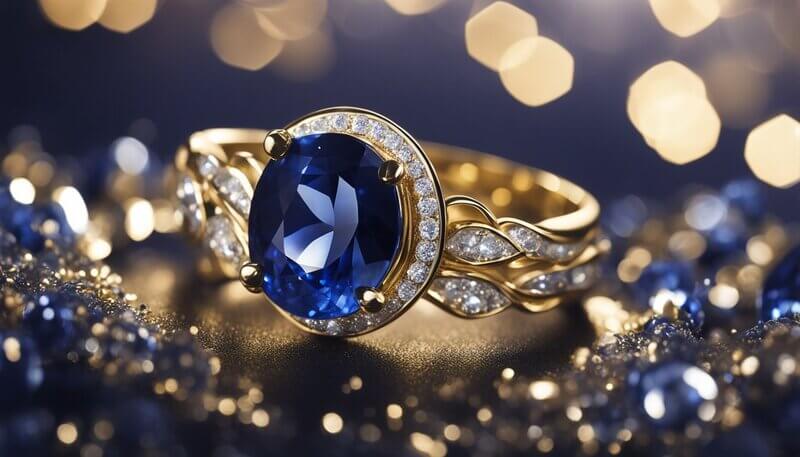
Sapphires, revered for their durability and vibrant spectrum of colors, are a prime choice for gemstone enthusiasts. This section will detail the essential characteristics of sapphires, including their color range, durability, and overall quality factors.
Color Range
Sapphires belong to the corundum family and are traditionally associated with a deep blue hue. However, they can occur in various colors, including yellow, pink, white, orange, green, purple, brown, and even colorless. Trace elements like iron, titanium, chromium, copper, or magnesium can influence the sapphire’s color.
Hardness and Durability
On the Mohs scale of mineral hardness, sapphires rank at 9.0, making them the third hardest mineral, just below diamond. This hardness contributes to their suitability for daily wear and versatility in jewelry. Due to their resilience, sapphires can be cleaned with a steam cleaner, although one must always check for any treatments that might affect the gemstone’s durability.
Clarity and Luster
Sapphires are expected to have inclusions, with clarity generally ranging from eye-clean to heavily included. Nonetheless, high-quality sapphires offer good transparency and a brilliant luster. The prominence of inclusions can significantly decrease a sapphire’s value, hindering the gemstone’s ability to reflect light.
Varieties of Sapphire

Prized for their durability and vibrant colors, Sapphires come in shades beyond the well-known blue. Each variety has its alluring characteristics and origins, drawing admirers and collectors alike.
Blue Sapphire
Blue sapphire is arguably the most recognized variety and holds significant allure due to its deep, rich hue, often described as cornflower blue. Historically, the most coveted blue sapphires hail from Kashmir, known for their velvety texture and unmatched color. However, other notable sources include Sri Lanka, which produces sapphires in various colors and intensities, and Montana, famed for sapphires with a more pastel tone. In addition, Australia is renowned for darker blue sapphires, typically with a slightly greenish undertone.
Fancy Sapphires
Fancy sapphires refer to sapphires that are not blue, encompassing a rainbow of colors such as violet, green, yellow, orange, pink, purple, and intermediate hues. Sri Lanka is a prominent source of fancy sapphires, offering a spectrum of exceptional colors. This variant’s value is determined by its color intensity, saturation, and rarity, with pink and purple hues being among the most sought-after.
Padparadscha Sapphire
The Padparadscha sapphire is a rare and valuable gemstone known for its pink-orange color, reminiscent of a tropical sunset. “Padparadscha” originates from Sinhalese, meaning ‘lotus color.’ These sapphires are primarily found in Sri Lanka but can also come from Madagascar and Tanzania. The delicate balance of pink and orange in a Padparadscha sapphire is the key to its beauty, with the finest examples displaying a vivid, evenly distributed color.
Sapphires in Jewelry
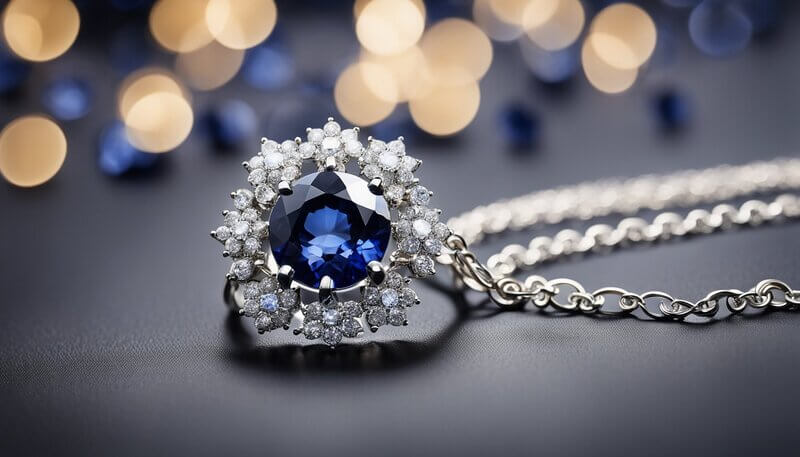
Sapphires are highly prized for their deep blues and striking clarity, making them a popular choice for all kinds of jewelry. These precious stones are often associated with nobility and are regularly fashioned into various adornments, from timeless rings to elegant neckpieces.
Rings
When it comes to rings, sapphires are a classic and durable option, often set into engagement rings as a symbol of fidelity. Their hardness, second only to diamonds, makes them ideal for daily wear. Sapphire rings come in various settings, including solitaire and accompanied by diamonds or other gemstones to enhance their deep blue hue.
- Solitaire Sapphire Rings
- Typically features a single sapphire, often cut in a round or oval shape
- Band material ranges from traditional gold to modern platinum or white gold
- Sapphire Engagement Rings
- Known for their durability and symbolism of loyalty
- Often paired with diamonds for a luxurious and eye-catching contrast
Necklaces and Brooches
Sapphires provide a regal centerpiece in necklaces and brooches or can be intricately arranged with other gemstones to create dazzling pendants and ornamental pieces.
Sapphire necklaces bring a touch of sophistication to any attire while brooches add a distinct element of timeless elegance.
- Sapphire Necklaces
- Designs range from simple pendants to elaborate multi-sapphire arrangements.
- The deep blues can vary in intensity, from light to a rich, velvety blue
- Brooches with Sapphires
- Brooches often feature sapphires as either the central stone or as accents in a larger design
- The stones are usually well-protected in bezel settings and can depict various motifs
Famous Sapphires
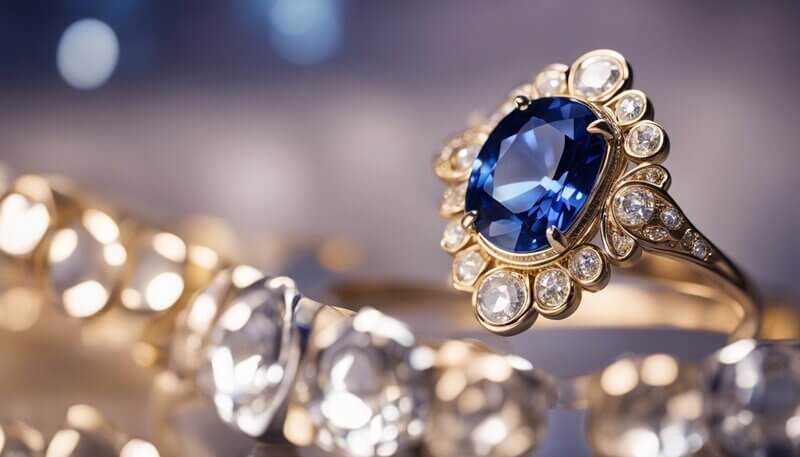
The world of gemstones is graced with various famous sapphires, each with a story that enhances their allure.
Among these, the Rockefeller Sapphire stands out—a 62.02-carat gem that once belonged to John D. Rockefeller, Jr. This rectangular step-cut stone hails from Myanmar and is notable for its exquisite clarity and vibrant blue hue. It boasts a significant history, having been acquired by Rockefeller from an Indian maharaja in 1934.
Another legendary piece is the Logan Blue Sapphire, housed at the Smithsonian Institution. At 423 carats, it is not just one of the largest known blue sapphires but also one recognized for its intense, deep blue color and exceptional transparency.
Sapphire Sourcing
Sapphires, the epitome of celestial glory and wisdom, are unearthed in a few prominent global locations. Each site is celebrated for yielding sapphires with distinct characteristics revered across the gemstone market.
- Sri Lanka: is renowned for its sapphires, which exhibit vibrant, shimmering hues. The stones from this island are widely acclaimed for their clarity and variety of colors, making them highly sought-after. They are especially prized for their exceptional blue sapphires.
- Madagascar: This newer source rose to fame rapidly due to its significant sapphire deposits. Madagascar sapphires can range from blue to pink, offering enthusiasts a spectrum of options.
- Myanmar: Formerly known as Burma, Myanmar is a historic source of sapphires. The term “Burmese sapphire” implies deep blue gemstones with a silky luster.
- United States: Although not as renowned as the Asian sources, the United States does contribute to sapphire production. Montana, for instance, is a notable mining locale within the country, hosting deposits that produce sapphires with a unique metallic hue.
Sapphire Sourcing Locations:
| Location | Notable Characteristics |
| Sri Lanka | Rich blue hues, variety of colors, high clarity |
| Madagascar | Wide color range, a recent significant discovery |
| Myanmar | Deep blue “Burmese” sapphires, historic source |
| United States | Unique metallic hues, especially in Montana |
Each source imbues its sapphires with a defining trait, be it the depth of color or the rarity of the hue, which influences the gemstone’s allure and value.
The trade of these precious stones is a complex network that connects remote mining areas to the bustling hubs of the jewelry world.
Birthstones and Zodiac

In the intriguing world of gemstones, each month is represented by a birthstone with unique significance, contributing to one’s identity through zodiac correlations and personal attributes.
September Birthstone
September’s prime gemstone is the sapphire, renowned for its deep blue hue and durability.
Sapphires transcend mere aesthetic value by potentially offering emotional and spiritual benefits. They symbolize purity, wisdom, and loyalty traditionally, making them an ideal gift for September birthdays.
The blue sapphire encapsulates September’s essence and is thought to align with the principles associated with the astrological signs of Virgo and Libra in this month.
Zodiac Correlations
The connection between birthstones and zodiac signs extends beyond September’s sapphire.
For instance, Aries, a sign from late March to April, is affiliated with the March birthstone, aquamarine, and the April birthstone, diamond.
Aquamarine is believed to bring courage and clarity, while diamonds confer strength and purity upon their wearers.
This correlation underscores a longer narrative in which gemstones serve as symbols of individual traits dictated by the zodiac and are commonly chosen as personalized gifts reflective of birth months and astrological significance.
Care and Maintenance of Sapphire
Sapphire jewelry requires specific care to retain its beauty and durability. The gemstone is robust, but proper handling and cleaning are essential.
Cleaning Methods
To clean sapphire jewelry effectively, one should adhere to the following steps:
- Create a Cleaning Solution: Mix warm water with mild dish soap to produce a gentle cleaning solution.
- Soak and Brush: Submerge the sapphire jewelry for a few minutes and then use a soft-bristled brush, such as a toothbrush, to remove any dirt or residue carefully.
- Rinse Thoroughly: The jewelry should be rinsed under lukewarm water to wash away any soapy residue after brushing.
- Dry and Polish: Gently pat the jewelry dry with a lint-free cloth and polish it to restore shine.
It’s important to avoid using harsh chemicals or abrasive materials that can damage the sapphire.
Regular inspection is also recommended to ensure the settings and prongs are secure.
Buying Guide for Sapphires
Selecting a sapphire is a thoughtful consideration for gifts, engagement rings, or personal jewelry. Understanding the qualities of this gemstone ensures value for money and satisfaction in its brilliance and charm.
Selecting the Right Sapphire
When choosing a sapphire, color is paramount.
Ideally, one seeks a stone exhibiting a rich, intense blue. A hint of violet is acceptable, but green or gray saturations should be avoided as they decrease the sapphire’s value.
A deep blue sapphire engagement ring signifies sincerity and faithfulness in a relationship, making it a fitting gift for a special occasion such as an engagement.
The cut of the sapphire also impacts its sparkle; a well-cut sapphire will reflect light to show its true depth and saturation.
Clarity is another critical criterion; look for a stone with minimal inclusions visible to the naked eye.
Note that, unlike diamonds, some inclusions are acceptable in sapphires. They can provide unique fingerprints, occasionally enhancing its value, particularly if they indicate the stone’s provenance from coveted locations like Kashmir or Ceylon.
Lastly, the size of the stone contributes to its statement, but one should balance size with color and clarity to find a harmonious gemstone for their jewelry.
Understanding Pricing
The price of sapphires varies considerably based on color, clarity, cut, and carat weight.
Vivid blue sapphires command the highest prices, with less-value paler or overly dark stones.
When considering a sapphire, one should also be aware that treated sapphires, commonly heated to enhance color and clarity, are more affordable than untreated stones which are exceptionally rare and prized.
While sapphires are typically less expensive than diamonds, they can sometimes be close to or even exceed diamonds’ value if they are of exceptional quality.
Though many may seek sapphires as an alternative to the traditional diamond engagement ring, sapphires hold their prestige in the realm of gemstones.
As with any significant investment in a piece of jewelry, purchasing sapphires from reputable sellers who can provide detailed information on the stone’s origins and any treatments it has undergone is recommended.
Sapphire’s Role in Cultures
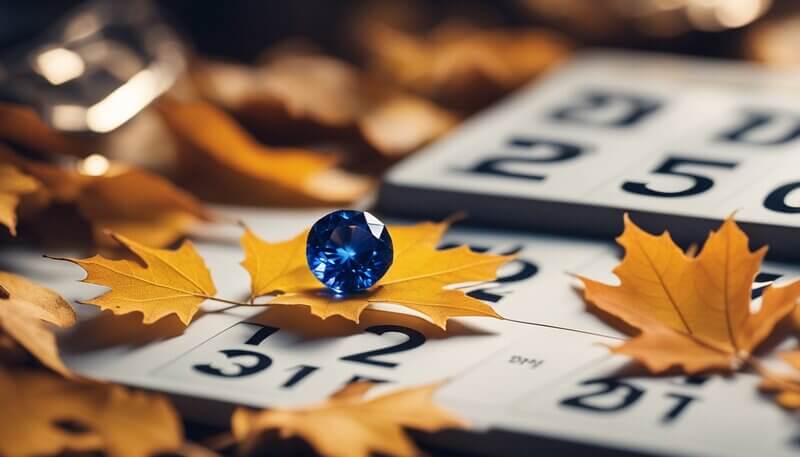
Various cultures have esteemed sapphires for their striking beauty and symbolic value.
Royalty often favored these gems; their deep blue hue was considered a symbol of the heavens. Monarchs and kings likely viewed the sapphire as a means of protection and a symbol of strength.
In religious contexts, the sapphire holds significant value as well.
It’s noted that clergy during the Middle Ages would wear sapphires to symbolize Heaven, and it is believed that the tablets containing the Ten Commandments were made of sapphire stone, reflecting purity and wisdom.
The gemstone’s durability and luster have led numerous cultures to associate it with loyalty and faithfulness.
It has been a popular choice for betrothal rings and gifts that signify a promise of fidelity.
Often worn by priests and other religious figures, the sapphire was thought to bring spiritual enlightenment and to guard against impure thoughts and deeds.
| Culture | Significance of Sapphire |
| Royalty | Power and Strength |
| Clergy | Heaven and Purity |
| Relationships | Loyalty and Faithfulness |
Frequently Asked Questions
This section addresses some of the most common inquiries regarding the gemstone that represents September birthdays. These questions range from details about traditional and modern variations of the birthstone to its historical significance and purported healing benefits.
1. What are the traditional and modern birthstones for September?
The traditional birthstone for September is the blue sapphire, valued for its deep, vivid color and durability. It remains the modern birthstone as well, often symbolizing wisdom and nobility.
2. How does the September birthstone’s color vary?
While the most well-known color for September’s birthstone is a rich, royal blue, sapphires can actually come in a range of colors, including pink, yellow, and green. The value of a stone can often be influenced by its hue, saturation, and tone.
3. What is the historical significance of September’s birthstone?
Historically, sapphires have been treasured since ancient times and were believed to protect their wearers from envy and harm. Royalty wore sapphires to symbolize divine favor and wisdom, making them a regal choice for September.
4. Are there any alternative gemstones associated with September?
Aside from the widely recognized sapphire, alternative birthstones like lapis lazuli are associated with September. Lapis lazuli, known for its deep blue color with golden flecks, provides more options for those seeking to celebrate September birthdays.
5. Can the September birthstone be worn by individuals not born in that month?
Absolutely. There are no restrictions on who can wear September’s birthstone. Sapphires are a popular choice for jewelry for anyone appreciating their beauty and range of colors, not just those born in September.
6. What are the healing properties and benefits of wearing September’s birthstone?
Sapphires are believed to offer a variety of healing properties. These include mental clarity, stress relief, and enhanced immunity. The stone promotes wisdom, focus, and calmness in the wearer.







